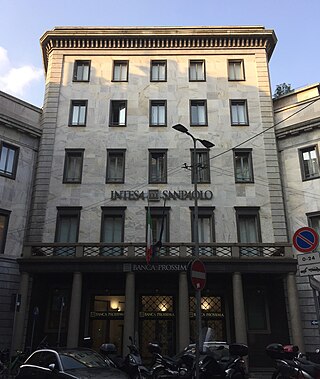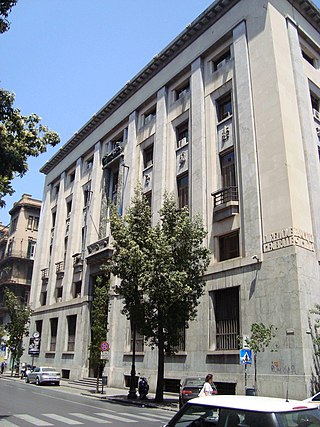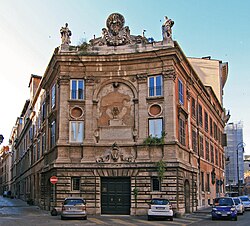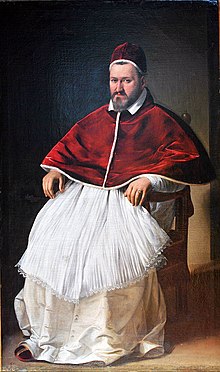
Banco Ambrosiano was an Italian bank that was established in 1896 and collapsed in 1982. The Vatican-based Institute for the Works of Religion, commonly known as the Vatican Bank, was Banco Ambrosiano's main shareholder. The Vatican Bank was accused of funnelling covert United States funds to the Polish trade union Solidarity and to the Nicaraguan Contras through Banco Ambrosiano.

Borgo is the 14th rione of Rome, Italy. It is identified by the initials R. XIV and is included within Municipio I.

Banca di Roma was an Italian bank based in Rome, formed in 1992 by merger of Banco di Santo Spirito and Banco di Roma. From 2008 it was a subsidiary of UniCredit under the name UniCredit Banca di Roma S.p.A.. In 2010 the subsidiary was absorbed into the bank, but retained as a registered trademark.
Capitalia was an Italian banking group headquartered in Rome, in existence between 2002 and 2008. The bank was a listed company in Borsa Italiana. The bank was acquired by UniCredit by issuing new shares of UniCredit for shares of Capitalia.

Banco di Sicilia was an Italian bank based in Palermo, Sicily. It was a subsidiary of UniCredit but absorbed into the parent company in 2010.

Church of the Holy Spirit in the Saxon District is a 12th-century titular church in Rome, Italy. It is in Borgo Santo Spirito, a street which got its name from the church, placed in the southern part of Rione Borgo. The current holder of the titulus is Cardinal-Deacon Dominique Mamberti. It has been the official sanctuary of Divine Mercy since 1994.

The Hospital of the Holy Spirit is the oldest hospital in Europe, located in Rome, Italy. It now serves as a convention center. The complex lies in rione Borgo, east of Vatican City and next to the modern Ospedale di Santo Spirito. The hospital was established on the site of the former Schola Saxonum, a part of the complex houses the Museo Storico.

Porta Santo Spirito is one of the gates of the Leonine walls in Rome (Italy). It rises on the back side of the Hospital of the same name, in Via dei Penitenzieri, close to the crossing with Piazza della Rovere.

Banco di Roma was an Italian bank based in Rome, established on 9 March 1880. In the early 20th century, it was one of Italy's four dominant universal banks, together with Banca Commerciale Italiana, Credito Italiano, and Società Bancaria Italiana. It developed a significant network throughout the Eastern Mediterranean and Italian Africa. In 1992 it eventually merged with the Banco di Santo Spirito and altered its name to Banca di Roma.
Bipop Carire S.p.A. was an Italian banking group based in Brescia, Lombardy. The group became part of Capitalia in 2002. Capitalia itself became part of UniCredit in 2007, which the brand Bipop Carire was absorbed into UniCredit in 2008. Bipop Carire was formed as a merger of Banca Popolare di Brescia (Bipop) and Cassa di Risparmio di Reggio Emilia (Carire) in 1999.
Bank of Rome may refer to:

Banca del Mezzogiorno – MedioCredito Centrale S.p.A. (BdM-MCC) is an Italian bank based in Rome, Lazio region. The bank is entirely controlled by Invitalia S.p.A., which in turn is owned by the Ministry of Economy. The bank was specialized in medium-term loan to companies, which developed into corporate and investment banking, and currently specialized in public sector, such as one of the manager of Fondo di Garanzia per le Piccole e Medie Imprese of the Ministry of Economic Development, and European Union's Joint European Resources for Micro to Medium Enterprises Calabria Fund. The bank lend medium-term loan from the fund to SMEs for Italian government and the European Union.
IRFIS – Finanziaria per lo Sviluppo della Sicilia S.p.A. also known as IRFIS – FinSicilia S.p.A., is an Italian development bank based in Palermo, Sicily. The bank is registered under article 106 and 107 of Testo Unico Bancario. The bank provided subsidized loans and intermediates for companies to access government incentives.
Banca Popolare del Molise was an Italian bank based in Campobasso, Molise.

Banca Popolare di Brescia S.c.r.l., also referred to as Bipop, was an Italian cooperative bank based in Brescia, Lombardy. In 1999 the bank merged with Cassa di Risparmio di Reggio Emilia (Carire) to form Bipop Carire.
The Cassa di Risparmio di Roma was an Italian savings bank, founded in 1836 by decree of Pope Gregory XVI. In 1991–92 the bank was reorganized, with its banking operations transferred to a subsidiary società per azioni (S.p.A.), which in turn was absorbed into Banca di Roma. The legal person of the former bank was renamed from Cassa di Risparmio di Roma to Fondazione Cassa di Risparmio di Roma, also known as Fondazione Roma, which also kept the bank's historic head office on Via del Corso 320.
Fondazione Roma formerly Fondazione Cassa di Risparmio di Roma is a charity organization based in Rome, Italy. The organization succeeds the historical financial institution Cassa di Risparmio di Roma as it was reorganized as a banking foundation in 1991, with its banking operations spun off to merge with other Roman banks and form Banca di Roma, later a component of Capitalia then Unicredit. The foundation remained as a shareholder of UniCredit, the banking group that acquired Capitalia in mid-2007. As at 31 December 2006, the foundation was the second largest shareholder of Capitalia for 5.02% stake.

Borgo Santo Spirito is a street in Rome, Italy, important for historical and artistic reasons. From a historical point of view, it is considered the most interesting street in the Borgo district. Of medieval origin, it is linked to the foundation of the ancient fortified hospice for pilgrims from England, the Burgus Saxonum. The street houses the oldest Roman hospital, the Arcispedale di Santo Spirito in Saxia, which gave it its name. Heavily altered during the works for the opening of Via della Conciliazione, it nevertheless avoided the fate of the two parallel streets of Borgo Nuovo and Borgo Vecchio, both destroyed.

The Banca Nazionale Toscana was a credit institution and bank of issue of the Grand Duchy of Tuscany, founded by merger in 1860. It maintained its activity in the Kingdom of Italy until being merged in 1893 with peers including the National Bank of the Kingdom of Italy, forming the Bank of Italy.

The Banca Romana was an Italian bank of issue founded in Rome in 1834. In 1850 it was reorganized as the Bank of the Papal States, which in 1870 itself changed its name to Banca Romana. In the late 1880s, its difficulties developed into the major Banca Romana scandal which shook Italy's political life and triggered the creation in 1893 of the Bank of Italy. The Bank of Italy managed the Banca Romana's subsequent liquidation.














